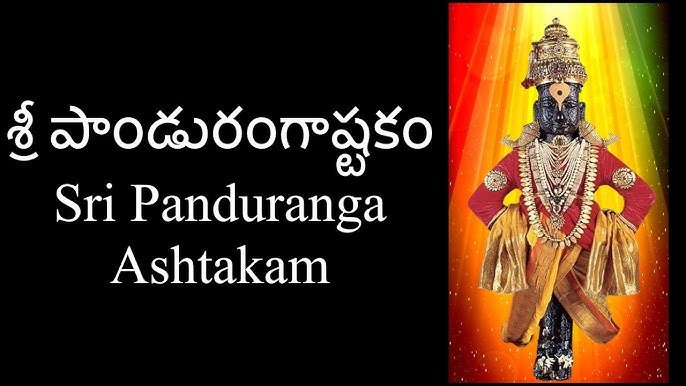Panduranga Ashtakam Stotram
Panduranga Ashtakam

The Panduranga Ashtakam is a beautiful and soul-stirring hymn composed by Adi Shankaracharya in praise of Lord Panduranga, also known as Vitthala or Vithoba, the presiding deity of Pandharpur in Maharashtra. This hymn, made up of eight melodious verses (ashtakam means “eight”), captures the essence of deep bhakti (devotion) and philosophical realization, blending the emotional and spiritual longing of a devotee with the non-dualistic wisdom that Shankaracharya is renowned for.
Lord Panduranga is depicted in this hymn as standing on a brick (vit) with arms akimbo, patiently waiting for his devotees, especially his greatest devotee, Sant Pundalik, who is said to have invoked the Lord with selfless service to his parents. The imagery used in the Ashtakam reflects both the intimate personal devotion and the grandeur of the Lord’s divine form — his lotus feet, his shining crown, the yellow garments like those of Krishna, and his charming yet serene face. In the first verse, the Lord is hailed as the “ocean of mercy,” the “refuge of the helpless,” and the “destroyer of fear.”
Shankaracharya calls out to Panduranga not as a distant God but as the indweller of the devotee’s heart, present within and without. The subsequent verses describe how the Lord transcends name and form, yet lovingly assumes a form to bless the devotees. He is the one who resides in Pandharpur, a holy town that has become synonymous with bhakti marga (the path of devotion), especially through the lives of saints like Tukaram, Namdev, Dnyaneshwar, and others who saw Panduranga as both God and friend.
The Panduranga Ashtakam reflects this same intimacy and surrender. Each verse highlights how the Lord uplifts those who surrender to him, bestows fearlessness, and grants liberation. What makes this hymn particularly powerful is its repetitive structure and the use of Nama smarana (chanting the name) — invoking “Panduranga” repeatedly builds a meditative rhythm and emotional connection with the deity. The language is devotional yet filled with Vedantic depth.
For instance, the Lord is described as “beyond maya (illusion), yet playing within it,” and as the “witness of all,” aligning with the Advaita (non-dual) philosophy that the Supreme Being is both immanent and transcendent. Devotees recite the Panduranga Ashtakam daily, particularly during the Ashadhi Ekadashi and Kartiki Ekadashi pilgrimages to Pandharpur, believing it brings peace of mind, devotion, and liberation from the cycle of birth and death. This hymn is not just a poetic expression but a doorway into deeper spiritual realization, affirming that even the highest truths can be accessed through loving devotion to the Lord.
In conclusion, the Panduranga Ashtakam is both a heartfelt song and a spiritual meditation — one that brings the devotee closer to the compassionate and ever-waiting Lord of Pandharpur, who stands eternally ready to bless those who approach him with sincerity and love.





















































